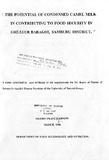| dc.description.abstract | This study was carried out in Baragoi and Nyiro divisions of Samburu district with the main
objectives of, first, determining the financial, social and physical accessibility of both fresh and
condensed camel milk to the community and, secondly, to determine the changes in the levels
of specific nutrients during evaporative condensation of camel milk as well as during storage.
A total of 147 randomly selected members of camel improvement groups were interviewed using
a structured questionnaire which had been previously pre-tested. Samples of fresh milk were
analysed for their content of vitamin A, vitamin e, total niacin, crude protein, lactose, total fat,
total ash, total carbohydrates and metabolizable energy using standard laboratory procedures.
Also, samples of condensed milk were analysed immediately after condensation, and thereafter
at intervals of 4 weeks during storage at room temperature, 24°e, 300e and 35°e.
Results showed that there were no cultural beliefs or food taboos that prohibited rearing of
camels or consumption of milk from them. The mean total milk consumption per household was
found to be 5.2 litres per day, out of which 1.7 litres were camel milk. It was found that
households owning camels had the potential to spare approximately 2.4 litres of camel milk per
day, which could be condensed and accumulated for use during the drought. During these
periods, households which do not own camels would have to depend on purchasing. It was,
however, established that it would cost about six times more to purchase a unit of energy from
condensed camel milk as it would to purchase the same unit from cereal grain.
Evaporative condensation led to loss of up to 36% of vitamin A, 22 % of vitamin C and 5% of
total niacin. There was also a loss of about 70% protein, 53% lactose and 6.7% total fat. The
ash content, however, increased slightly during condensation. The levels of vitamin A and
lactose remained stable in the first four weeks of storage, but declined in the second four weeks.
Levels of vitamin C, protein, total ash and niacin remained fairly stable during storage. Moisture
levels increased during the second month of storage whereas mould were noticed in the samples
in the 9th week of storage. In all cases, there were no statistical differences in the changes in
levels of the nutrients at different temperatures during storage. Larger changes in nutrient levels
were found in the samples that had been opened for sampling in the course of storage, than those
that were not, although these were not significantly different from the levels in the samples that
had not been scooped from.
The findings from this study suggest that condensed camel milk could be a potential energy
supplement for camel owners during prolonged dry periods. However, it would 'be an expensive
source of energy for those who do not produce and condense their own milk. This justifies the
need to encourage camel ownership in Baragoi. | en |

